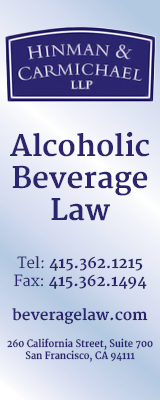FREE! Subscribe to News Fetch, THE daily wine industry briefing - Click Here
![Banner_Xpur_160x600---Wine-Industry-Insight[63]](/wp-content/uploads/Banner_Xpur_160x600-Wine-Industry-Insight63.jpg) |
 ALSO SPONSORED BY: 
Wine Industry Insight |
 |
Wine Has A Problem Because It Is “Sold.” Badly. Or Not At All
There’s been this statement floating around recently that “wine is sold, not bought.” And that’s a problem.
Because, when wine is sold, it is most often sold badly or not at all.
Which is why wine is now losing out to beer and spirits.

This wine was “SOLD. “Image and comment from Instagram
To keep wine sales growing means that the industry must give consumers accurate buying recommendation tools to keep the gambling process from becoming a bad experience that moves the next purchase over into beer and spirits sections.
Few Opportunities to “Sell” Wine. Consumers Are “Buying”
This Wines & Vines chart (below) based on Wine Market Council Data (Wine Consumers Thirsty for Other Beverages) deals with “frequent” wine drinkers and shows just how few actual opportunities there are to “sell” wine.

Several data points from the Wine Market Council (WMC) study reveal a depressing reality for the wine industry:
- Frequent drinkers are only 33% of wine drinkers and consume it several times a week or daily.
- Occasional wine drinkers consume once a week or less often.
- Over the past two years, occasional wine drinkers are buying 13% LESS wine. Frequent drinkers are drinking 14% more, but it it clear that wine is losing a base of potential customers.
Sliced Another Way, The Data Is Even Scarier

- 15% of Americans drink wine daily or several times a week.
- 29% of Americans drink wine once a week or less often.
- 21% of Americans drink alcohol, but no wine at all.
Losing The Future
The current WMC data show that:
- 41% of Boomers drink wine. 29% of Millennials, 18% of Gen X.
And other WMC data indicate that wine is for older people:
“A look at the data by ten-year age brackets revealed that the High Frequency wine drinker pool included a larger proportion of both 60+ men (18% vs. 9% of the Occasional wine drinker pool) and 60+ women (18% vs. 11% of the Occasional wine drinker pool), while the Occasional wine drinker segment was made up of a larger proportion of young, 21 – 30 year old, women (15% vs. 5%).
Selling Works Badly Even When It Has A Chance
And even among frequent wine drinkers, more than half of all wine is bought in supermarkets or grocery stores where there is almost never anyone there to sell. And when there is, the result can turn out like the Instagram post above.
And as a frequent wine drinker, I find that even with knowledgeable sales people in specialty wine stores, I end up pouring one of every three bottles down the drain. Not because the wine is spoiled, but because it’s not anywhere near my taste preferences.
Why Selling Fails
Selling — whether online or face-to-face — is destined to fail because of misunderstandings, genetics, and psychological factors:
The face-to-face process also faces a further uphill battle. Even if it were 100% accurate, the face-to-face process is filled with a lot of time friction. Only the most devoted are willing spend with an expert when what they really want is a fast, easy way to find a bottle they will like.
Likewise, spending long periods searching through wine reviews — online or dead-tree — presents the same sort of time friction. This also fails because it does not scale: 3/4 of all the wine available in the United States has never been reviewed.
No Opportunity To SELL to Most Wine Drinkers
Data is not available, but it is likely that grocery stores and other “non-expert-equipped” outlets get the lion’s share of sales from the vast majority — 67% — of wine wine drinkers who consume it once a week or less often.
That means there is NO opportunity to SELL … thus they must have tools to BUY.




